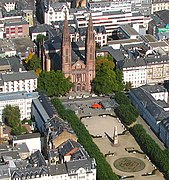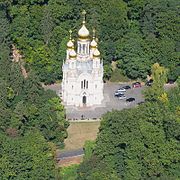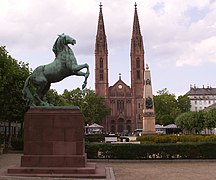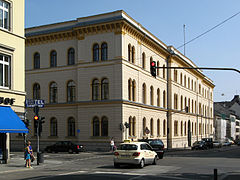Philipp Hoffmann (architect)
Philipp Hoffmann (born November 23, 1806 in Geisenheim ; † January 3, 1889 in Sanremo , buried in Wiesbaden) was an architect and city builder. First he studied architecture in Munich at the Academy of Fine Arts. In the period up to 1832 Hoffman made several trips to his training, including a. to Berlin, Italy and Austria.
Act
In 1830 he became a building assessor in the Nassau state service, which is why he was mainly active in the Nassau Residenz Wiesbaden from 1832 . As a young architect, he was initially responsible for developing the designs for the “ Rheingau Cathedral ” in his native Geisenheim in neo-Gothic forms (1834–1838). Hoffmann was then involved in the construction of the Wiesbaden City Palace (1837–1841) when he was sent to Pompeii by its builder Georg Moller for six months to draw Roman paintings that later served as the basis for the interior design of the palace.
In this way, he gained the attention of Duke Wilhelm , who promoted him to Duke-Nassau court architect in 1850 . In this role he was responsible for numerous buildings in Wiesbaden, including the Bonifatius Church (1844-1849), the Russian Orthodox Church (1847-1855) as a building of national importance and the Monopteros (1851) on the Neroberg, as well as with his participation under the architect Carl Boos the ministerial building , which today houses the Hessian Ministry of Justice (1854). Then the synagogue on Michelsberg (1863–1869) destroyed in 1938 , the Waterloo monument on Luisenplatz (1865) and the Kaiser-Wilhelms-Heilanstalt (1868–1871, also known as the Wilhelmsbau, former military hospital ), which is now part of the city palace complex . During these activities, Philipp Hoffmann was taken on as a civil servant in Prussia's state services in 1866. At the age of 64 he was given the rank of royal in 1870. Senior building councilor retired from civil service. Even after his retirement, the mentioned sanatorium was completed by 1871 and buildings were erected outside Wiesbaden, such as the Anglican Church (1874), dedicated to the English spa guests in Bad Schwalbach, and the conversation and society house , today's spa house in Bad Schwalbach (1879). Hoffmann was given a special honor in 1886 when he was awarded the title of Privy Court Building Councilor on behalf of Emperor Wilhelm I.
Picture gallery
Old synagogue on the Michelsberg
See also
literature
- Nikolas Werner Jacobs: Style and Historicity. Philipp Hoffmann's Gothic reception and its significance for his architectural work. In: Nassauische Annalen , Vol. 125 (2014), pp. 185–225.
- Manfred Laufs (Ed.): Philipp Hoffmann (1806–1889). (Workbooks of the State Office for Monument Preservation Hessen, Volume 12), Theiss, Stuttgart 2007, ISBN 3-8062-2166-9 .
Web links
- Paragraph about Philipp Hoffmann under History of the City of Bad Schwalbach . In: Website of the city of Bad Schwalbach
| personal data | |
|---|---|
| SURNAME | Hoffmann, Philipp |
| BRIEF DESCRIPTION | German architect and master builder |
| DATE OF BIRTH | November 23, 1806 |
| PLACE OF BIRTH | Geisenheim |
| DATE OF DEATH | January 3, 1889 |
| Place of death | Sanremo |










